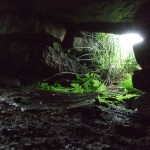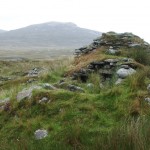Morsgail Beehives
The Morgail Beehives (NB 131199), a group of corbelled huts of unknown date, are described thus by Historic Scotland:
Group of corbelled “bee-hive” type shielings, built in remote moorland close to a stream, above Abhainn a Loin. Only one cell had roof intact at time of inspection (1989). Building date not know, but likely to pre-date population clearances of 19th century; they represent an ancient building technique, using the only materials available to hand to construct effective weatherproof shelters. Principally, a group of 3 adjoining cells, the outer 2 now with roofs fallen/knocked in; inner cell surviving – it has 2 flat-lintelled low entrances, one (the lower) west-facing, the other opening in to the intercommunicating southmost cell. Built of undressed rubble, neatly-built when seen from inside, part covered with soil/torves, possibly thickly-turved when in use.
WC Mackenzie made the following notes for the Scottish Society of Antiquities in 1904 regarding beehives in general in Uig and Bernera, drawing on the writings of Captain Thomas who wrote of them in 1858.
When we seek local information as to the construction of these bothain we meet with nothing but professions of absolute ignorance. “Wherever placed,” writes Captain Thomas, “all the native agree that no one knows who built them, and that they were not made by the fathers nor grandfathers of persons now living.” This general statement however he qualifies by reporting an assersion “that one was built by a person who is still alive” (1858), and later (1867) gives as his conclusion “from various circumstances” that the both at Cnoc Dubh “was made about ninety years back.”
Struck with these two unique exceptions, I made careful inquiry of an informant in every way excellently qualified to speak on the subject, witht eh result that he refuses to admit these exceptions, and reiterates the entire local ignorance of the origin of these buildins. “My grandfather,” he writes, “whom I well remember, lived here and among the beehives 105 years; my father lived 87 years and I am 50 years – perhaps the longest pedigree that can be found in Lewis or Harris. I have to say that the beehives were as ancient and mysterious to my grandfather as they were to my father and me. There is not the slightest recollection of even the tradition of who built them, any more than of those who built the old Duns or Druidical Stones.” On the particular point at issue he is emphatic in declaring that he cannot accept the statement recorded by Captain Thomas – which, I may add, has passed in to general and unqualified acceptance; adding that all it may mean is that the man may have helped “to renovate and bring an ancient beehive to a modern summer shieling, as many now living here have seen done.”
The Glen Marstaig beehives with which he was personally familiar were, he informs me, reduced to summer shielings in 1832, and remained in use for that purpose until 1872, when the people were deprived of the grazing in order that the ground might be converted into a deer-forest.




